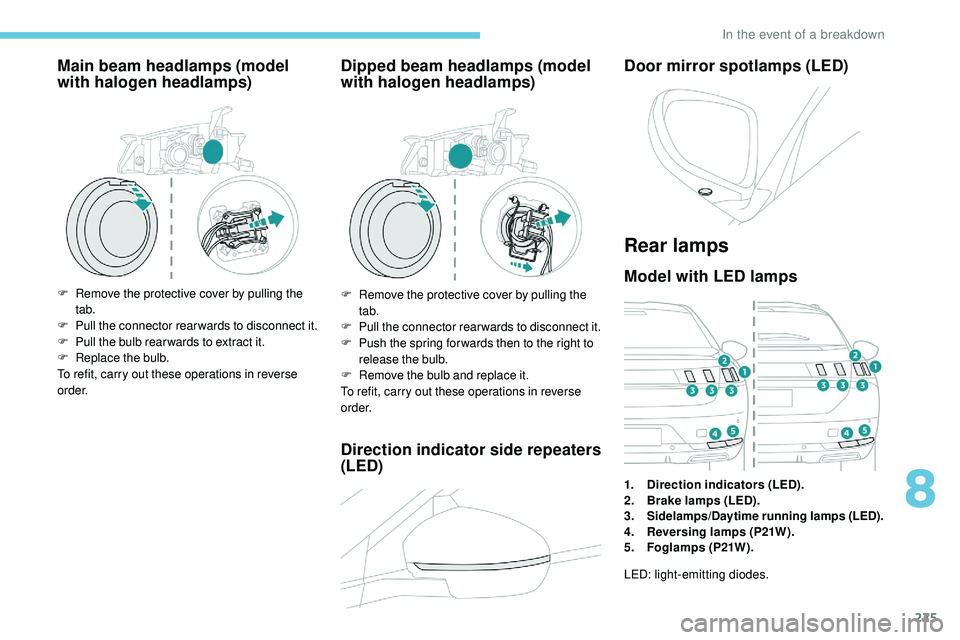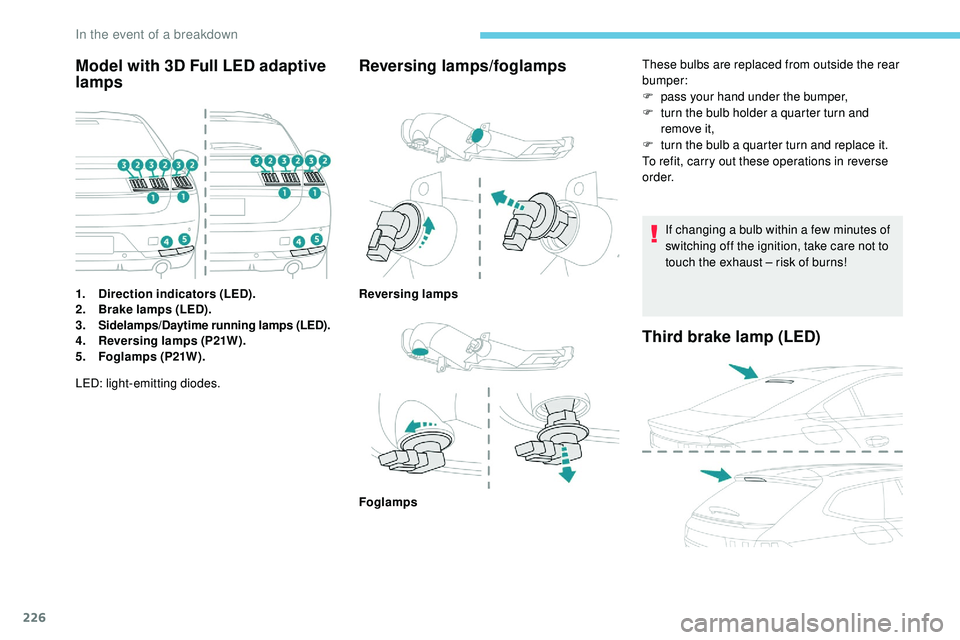2019 Peugeot 508 bulb
[x] Cancel search: bulbPage 5 of 320

3
.
bit.ly/helpPSA
.
Driving recommendations 124
Anti-theft protection 1 25
Starting/Switching off the engine
1
25
Electric parking brake
1
28
Manual gearbox
1
31
Automatic gearbox
1
31
Hill start assist
1
35
Active Suspension Control
1
36
Driving modes
1
36
Gear shift indicator
1
38
Stop & Start
1
38
Tyre under-inflation detection
1
40
Speed Limit recognition and
recommendation
1
42
Speed limiter
1
46
Programmable cruise control
1
48
Memorising speeds
1
51
Drive Assist Plus
1
51
Adaptive cruise control
1
52
Lane Positioning Assist
1
61
Active Safety Brake with Distance Alert
and Intelligent emergency braking
assistance
165
Fatigue detection system
1
69
Active Blind Spot Monitoring System
1
70
Active Lane Keeping Assistance
1
71
Blind Spot Detection
1
74
Parking sensors
1
76
Visiopark 1 – Visiopark 2
1
79
Park Assist
1
84
Full Park Assist
1
88Compatibility of fuels
1 97
Refuelling 1 98
Misfuel prevention (Diesel)
1
99
Towing device
1
99
Towing device with retractable towball
2
00
Load reduction mode
2
01
Energy economy mode
202
S
now chains
2
02
Fitting roof bars
2
03
Bonnet
204
Engine compartment
2
05
Checking levels
20
5
Checks
20
8
Advice on care and maintenance
2
10
AdBlue
® (BlueHDi engines) 2 10
Warning triangle
2
13
Running out of fuel (Diesel)
2
13
Tool kit
2
14
Temporary puncture repair kit
2
16
Spare wheel
2
19
Changing a bulb
2
23
Changing a fuse
2
27
12 V battery
2
33
Towing the vehicle
2
36Engine technical data and towed loads
2
38
Engines and towed loads – Petrol
2
39
Engines and towed loads – Diesel
2
40
Dimensions
2
42
Identification markings
2
43
Driving
Practical information
In the event of a breakdown Technical data
Alphabetical index
Access to additional videos
Audio equipment and telematics
PEUGEOT Connect Radio
PEUGEOT Connect Nav
.
Contents
Page 100 of 320

98
General safety
recommendations
Labels are affixed in different locations on
your vehicle. They include safety warnings
and vehicle identification information. Do
not remove them: they are an integral part
of your vehicle.
For any work on your vehicle, use a
qualified workshop that has the technical
information, skills and equipment required,
all of which a PEUGEOT dealer is able to
provide.
Depending on country regulations, some
safety equipment may be compulsory:
high visibility safety vests, warning
triangles, breathalysers, spare bulbs,
spare fuses, fire extinguisher, first aid kit,
mud flaps at the rear of the vehicle, etc.We draw your attention to the following
points:
-
T
he fitting of electrical equipment
or accessories not approved by
PEUGEOT may cause excessive
current consumption and faults and
failures with the electrical system of
your vehicle. Contact a PEUGEOT
dealer for information on the range of
recommended accessories.
-
A
s a safety measure, access to
the diagnostic socket, used for the
vehicle's electronic systems, is
reser ved strictly for PEUGEOT dealers
or qualified workshops, equipped
with the special tools required (risk
of malfunctions of the vehicle's
electronic systems that could cause
breakdowns or serious accidents).
The manufacturer cannot be held
responsible if this advice is not
followed.
-
A
ny modification or adaptation not
intended or authorised by PEUGEOT
or carried out without meeting the
technical requirements defined
by the manufacturer will result in
the suspension of the legal and
contractual
warranties.Installation of accessory radio
communication transmitters
Before installing a radio communication
transmitter, you must contact a PEUGEOT
dealer for the specifications of compatible
transmitters (frequency, maximum power,
aerial position, specific installation
requirements), in line with the Vehicle
Electromagnetic Compatibility Directive
(2004/104/EC).
Hazard warning lamps
F When you press this red button, all four
direction indicators flash.
They can operate with the ignition off.
Safety
Page 225 of 320

223
After changing a wheel
With a "space-saver" type spare wheel
Driving with more than one "space-saver"
type spare wheel is prohibited.Visit a PEUGEOT dealer or a qualified
workshop as soon as possible to have the
tightness of the bolts and the pressure of
the spare wheel checked.
Have the punctured tyre examined. After
inspection, the technician will advise you
on whether the tyre can be repaired or if it
must be replaced.
Changing a bulb
The headlamps have polycarbonate
lenses with a protective coating:
F
d
o not clean them using a dr y or
abrasive cloth, nor with a detergent
or solvent product,
F
u
se a sponge and soapy water or a pH
neutral product,
F
w
hen using a high pressure washer
on persistent marks, do not keep the
lance directed towards the lamps or
their edges for too long, so as not to
damage their protective coating and
seals. Changing a bulb must only be done with
the ignition off and after the lamp has
been switched off for several minutes –
Risk of serious burns!
F
D
o not touch the bulb directly with your
fingers, use a lint-free cloth.
It is essential only to use anti-ultraviolet
(UV) type bulbs, so as not to damage the
headlamp.
Always replace a failed bulb with a new
bulb with the same type and specification.
In some weather conditions (e.g. low
temperature or humidity), the presence
of misting on the internal sur face of the
glass of the headlamps and rear lamps
is
normal; it disappears after the lamps
have been on for a few minutes.
Light-emitting diodes (LED)
For the replacement of this type of bulb,
you must contact a PEUGEOT dealer or
a
qualified workshop.
F
T
ighten the other bolts using wheelbrace
5
o n l y.
F
R
efit the bolt covers to each of the bolts
(depending on equipment).
F
S
tore the tools.
The following is recommended:
-
d
eactivate certain driving aid functions
(Active Safety Brake, Adaptive cruise
control, etc.), as indicated on the label
attached to the wheel,
-
d
o not exceed the maximum
authorised speed of 50 mph (80
km/h).
8
In the event of a breakdown
Page 226 of 320

224
Halogen bulbs
To ensure good quality lighting, check
that the bulb is correctly positioned in its
housing.
Front lamps
Model with "Full LED"
technology headlamps
1.Daytime running lamps/Sidelamps/
Direction indicators (LED).
2. Dipped beam headlamps (LED).
3. Main beam headlamps (LED).
4. Static cornering lamps (LED).
Do not touch the "Full LED" technology
headlamps. Risk of electrocution!
Call a PEUGEOT dealer or a qualified
workshop.
Model with halogen headlamps
1.Daytime running lamps/Sidelamps (LED).2.Main beam headlamps (H7).
3. Dipped beam headlamps (H7).
4. Direction indicators (PWY24W).
Opening of bonnet /Access to bulbs
If the engine is warm, proceed with
caution – Risk of burns!
Take care with objects or clothing that
could be caught in the blades of the
engine fan – Risk of strangulation!
After changing a bulb
When refitting, close the protective cover
very carefully to guarantee the sealing of
the lamp.
Direction indicators (model with
halogen headlamps)
Rapid flashing of the direction indicator
lamp (left or right) in the instrument panel
indicates that one of the bulbs on the
corresponding side has failed.
F
T
urn the bulb holder a quarter turn and pull
it out.
F
T
urn the bulb a quarter turn and replace it.
To refit, carry out these operations in reverse
o r d e r.
Amber coloured bulbs, such as the
direction indicators, must be replaced
by bulbs with identical colour and
specifications.
In the event of a breakdown
Page 227 of 320

225
Main beam headlamps (model
with halogen headlamps)
F Remove the protective cover by pulling the tab.
F
P
ull the connector rear wards to disconnect it.
F
P
ull the bulb rear wards to extract it.
F
R
eplace the bulb.
To refit, carry out these operations in reverse
o r d e r.
Dipped beam headlamps (model
with halogen headlamps)
F Remove the protective cover by pulling the tab.
F
P
ull the connector rear wards to disconnect it.
F
P
ush the spring for wards then to the right to
release the bulb.
F
R
emove the bulb and replace it.
To refit, carry out these operations in reverse
o r d e r.
Direction indicator side repeaters
(LED) Door mirror spotlamps (LED)
Rear lamps
Model with LED lamps
1.
Direction indicators (LED).
2. Brake lamps (LED).
3.
Sidelamps/Daytime running lamps (LED).4. Reversing lamps (P21W).
5. Foglamps (P21W).
LED: light-emitting diodes.
8
In the event of a breakdown
Page 228 of 320

226
Model with 3D Full LED adaptive
lamps
1.Direction indicators (LED).
2. Brake lamps (LED).
3.
Sidelamps/Daytime running lamps (LED).4. Reversing lamps (P21W).
5. Foglamps (P21W).
Reversing lamps/foglamps
LED: light-emitting diodes. These bulbs are replaced from outside the rear
bumper:
F
p
ass your hand under the bumper,
F
t
urn the bulb holder a quarter turn and
remove it,
F
t
urn the bulb a quarter turn and replace it.
To refit, carry out these operations in reverse
o r d e r.
If changing a bulb within a few minutes of
switching off the ignition, take care not to
touch the exhaust – risk of burns!
Reversing lamps
Foglamps
Third brake lamp (LED)
In the event of a breakdown